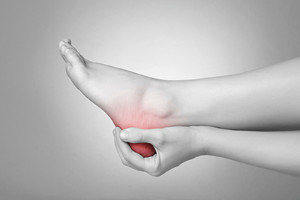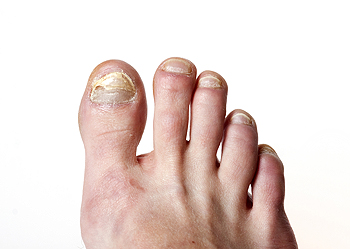Items filtered by date: February 2020
Arthritis Can Cause Pain in the Feet and Ankles
How to Practice Daily Foot Care
 The feet are considered to be the foundation of the body, which is why it is important to take proper care of them. When this is properly accomplished, mobility and flexibility may be improved, and general aches and pains may diminish. Common foot problems that may be prevented by maintaining healthy feet can include bunions, hammertoes, and tendinitis. It is important to wear shoes that fit properly, maintain a healthy weight, and practice good foot hygiene. Additionally, it may be beneficial to perform gentle stretching techniques, which may help the feet to become strong. If additional information is needed about the importance of learning everyday foot care, please consult with a podiatrist.
The feet are considered to be the foundation of the body, which is why it is important to take proper care of them. When this is properly accomplished, mobility and flexibility may be improved, and general aches and pains may diminish. Common foot problems that may be prevented by maintaining healthy feet can include bunions, hammertoes, and tendinitis. It is important to wear shoes that fit properly, maintain a healthy weight, and practice good foot hygiene. Additionally, it may be beneficial to perform gentle stretching techniques, which may help the feet to become strong. If additional information is needed about the importance of learning everyday foot care, please consult with a podiatrist.
Everyday foot care is very important to prevent infection and other foot ailments. If you need your feet checked, contact Jim Maxka, DPM from South Penn Foot & Ankle Associates. Our doctor can provide the care you need to keep you pain-free and on your feet.
Everyday Foot Care
Often, people take care of their bodies, face and hair more so than they do for their feet. But the feet are a very important aspect of our bodies, and one that we should pay more attention to. Without our feet, we would not be able to perform most daily tasks.
It is best to check your feet regularly to make sure there are no new bruises or cuts that you may not have noticed before. For dry feet, moisturizer can easily be a remedy and can be applied as often as necessary to the affected areas. Wearing shoes that fit well can also help you maintain good foot health, as well as making it easier to walk and do daily activities without the stress or pain of ill-fitting shoes, high heels, or even flip flops. Wearing clean socks with closed shoes is important to ensure that sweat and bacteria do not accumulate within the shoe. Clean socks help to prevent Athlete’s foot, fungi problems, bad odors, and can absorb sweat.
If you have any questions please feel free to contact our office located in Hanover, PA . We offer the newest diagnostic and treatment technologies for all your foot and ankle needs.
Where Is the Plantar Fascia?
The plantar fascia is located at the bottom of the foot. It connects the heel to the toes, and if inflamed, may be referred to as the condition plantar fasciitis. Risk factors which may precede a plantar fascia injury can include wearing shoes that do not have adequate support, or standing on hard surfaces for the majority of the day. Additionally, existing medical conditions such as flat feet or obesity may play a significant role in developing plantar fasciitis. Common symptoms of this condition can include pain in the heel and surrounding area, and the discomfort may be more intense after arising in the morning. Some patients find it helpful to perform specific exercises that are designed to decrease a portion of the pain and swelling. If you are afflicted with this ailment, please schedule a consultation with a podiatrist as quickly as possible so the correct treatment can begin.
Plantar fasciitis is a common foot condition that is often caused by a strain injury. If you are experiencing heel pain or symptoms of plantar fasciitis, contact Jim Maxka, DPM from South Penn Foot & Ankle Associates. Our doctor can provide the care you need to keep you pain-free and on your feet.
What Is Plantar Fasciitis?
Plantar fasciitis is one of the most common causes of heel pain. The plantar fascia is a ligament that connects your heel to the front of your foot. When this ligament becomes inflamed, plantar fasciitis is the result. If you have plantar fasciitis you will have a stabbing pain that usually occurs with your first steps in the morning. As the day progresses and you walk around more, this pain will start to disappear, but it will return after long periods of standing or sitting.
What Causes Plantar Fasciitis?
- Excessive running
- Having high arches in your feet
- Other foot issues such as flat feet
- Pregnancy (due to the sudden weight gain)
- Being on your feet very often
There are some risk factors that may make you more likely to develop plantar fasciitis compared to others. The condition most commonly affects adults between the ages of 40 and 60. It also tends to affect people who are obese because the extra pounds result in extra stress being placed on the plantar fascia.
Prevention
- Take good care of your feet – Wear shoes that have good arch support and heel cushioning.
- Maintain a healthy weight
- If you are a runner, alternate running with other sports that won’t cause heel pain
There are a variety of treatment options available for plantar fasciitis along with the pain that accompanies it. Additionally, physical therapy is a very important component in the treatment process. It is important that you meet with your podiatrist to determine which treatment option is best for you.
If you have any questions, please feel free to contact our office located in Hanover, PA . We offer the newest diagnostic and treatment technologies for all your foot care needs.
Sever’s Disease Typically Affects Teenagers
 The condition that is known as Sever’s disease is considered to be an inflammation of the growth plate that is located in the back of the heel. It typically occurs in teenagers who are physically active, and may be the result of growth spurts. This can happen when the bones in the foot grow faster than the muscles and tendons. Common symptoms that are often associated with this condition can consist of pain in the heel, which can become worse after a running or jumping activity has been completed. Research has indicated that it is beneficial to treat Sever’s disease as soon as it is properly diagnosed, as this may help to accelerate a prompt recovery. If your child complains of having heel pain, it is advised that you schedule an appointment with a podiatrist who can help your child to manage this condition.
The condition that is known as Sever’s disease is considered to be an inflammation of the growth plate that is located in the back of the heel. It typically occurs in teenagers who are physically active, and may be the result of growth spurts. This can happen when the bones in the foot grow faster than the muscles and tendons. Common symptoms that are often associated with this condition can consist of pain in the heel, which can become worse after a running or jumping activity has been completed. Research has indicated that it is beneficial to treat Sever’s disease as soon as it is properly diagnosed, as this may help to accelerate a prompt recovery. If your child complains of having heel pain, it is advised that you schedule an appointment with a podiatrist who can help your child to manage this condition.
Sever's disease often occurs in children and teens. If your child is experiencing foot or ankle pain, see Jim Maxka, DPM from South Penn Foot & Ankle Associates. Our doctor can treat your child’s foot and ankle needs.
Sever’s Disease
Sever’s disease is also known as calcaneal apophysitis, which is a medical condition that causes heel pain I none or both feet. The disease is known to affect children between the ages of 8 and 14.
Sever’s disease occurs when part of the child’s heel known as the growth plate (calcaneal epiphysis) is attached to the Achilles tendon. This area can suffer injury when the muscles and tendons of the growing foot do not keep pace with bone growth. Therefore, the constant pain which one experiences at the back of the heel will make the child unable to put any weight on the heel. The child is then forced to walk on their toes.
Symptoms
Acute pain – Pain associated with Sever’s disease is usually felt in the heel when the child engages in physical activity such as walking, jumping and or running.
Highly active – Children who are very active are among the most susceptible in experiencing Sever’s disease, because of the stress and tension placed on their feet.
If you have any questions, please feel free to contact our office located in Hanover, PA . We offer the newest diagnostic and treatment technologies for all your foot and ankle injuries.
Possible Causes of Toenail Fungus
 A common ailment that can affect the toenails is known as toenail fungus. It generally develops gradually, and can occur as a result of being exposed to a certain type of fungus. The environments where this type of fungus lives and thrives may include public swimming pools, locker rooms, and shower room floors. It generally grows in warm and moist areas, and it is advised that appropriate shoes are worn while in these particular places. Additional reasons why patients may develop this ailment can consist of using artificial nails, wearing closed shoes for the majority of the time, or medical conditions such as diabetes or a weakened immune system. There are different treatment options available for toenail fungus, and it is suggested that you seek the counsel of a podiatrist who can determine what the best remedy is for you.
A common ailment that can affect the toenails is known as toenail fungus. It generally develops gradually, and can occur as a result of being exposed to a certain type of fungus. The environments where this type of fungus lives and thrives may include public swimming pools, locker rooms, and shower room floors. It generally grows in warm and moist areas, and it is advised that appropriate shoes are worn while in these particular places. Additional reasons why patients may develop this ailment can consist of using artificial nails, wearing closed shoes for the majority of the time, or medical conditions such as diabetes or a weakened immune system. There are different treatment options available for toenail fungus, and it is suggested that you seek the counsel of a podiatrist who can determine what the best remedy is for you.
If left untreated, toenail fungus may spread to other toenails, skin, or even fingernails. If you suspect you have toenail fungus it is important to seek treatment right away. For more information about treatment, contact Jim Maxka, DPM of South Penn Foot & Ankle Associates. Our doctor can provide the care you need to keep you pain-free and on your feet.
Symptoms
- Warped or oddly shaped nails
- Yellowish nails
- Loose/separated nail
- Buildup of bits and pieces of nail fragments under the nail
- Brittle, broken, thickened nail
Treatment
If self-care strategies and over-the-counter medications does not help your fungus, your podiatrist may give you a prescription drug instead. Even if you find relief from your toenail fungus symptoms, you may experience a repeat infection in the future.
Prevention
In order to prevent getting toenail fungus in the future, you should always make sure to wash your feet with soap and water. After washing, it is important to dry your feet thoroughly especially in between the toes. When trimming your toenails, be sure to trim straight across instead of in a rounded shape. It is crucial not to cover up discolored nails with nail polish because that will prevent your nail from being able to “breathe”.
In some cases, surgical procedure may be needed to remove the toenail fungus. Consult with your podiatrist about the best treatment options for your case of toenail fungus.
If you have any questions, please feel free to contact our office located in Hanover, PA . We offer the newest diagnostic and treatment technologies for all your foot care needs.


